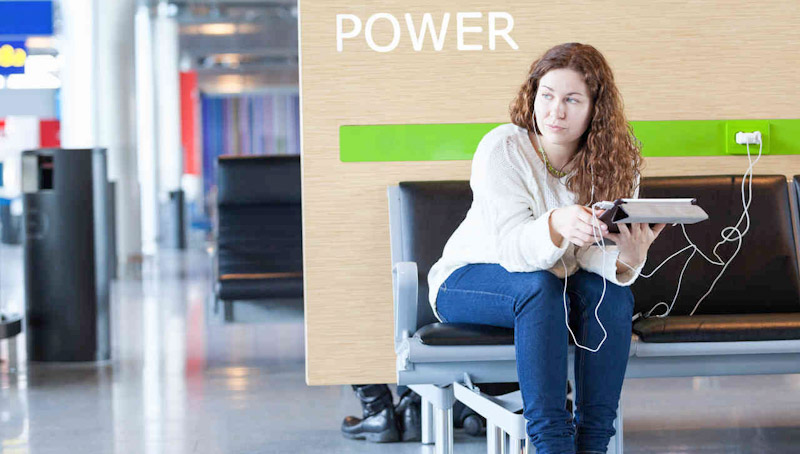Are you old enough to remember getting only a few hours from a full charge of your phone or laptop? Carrying around backup batteries or waiting forever to recharge your notebook? Even if you’re not that “old”, you’d still be as excited as we are about the new fast charging technology that’s now available.
These days your phone, tablet and laptop are a lot more powerful — with ever faster processors, crisper displays, and better cameras. And to top it all off, new 5G networks are finally here in a limited number of test cities. But although 5G is a lot faster than 4G, it uses more battery power.
The bottom line to all of this? You’ll need more and faster charging power for your devices whether you’re mobile, or you’re at home.
Thankfully, better charging technology is here to rescue us in time for the new 5G revolution. Here’s the latest so far in new fast charging technology:
New battery technology
You have three main solutions to slow down fast battery drain — and the first would be to use a new type of battery. Nearly all of the portable devices that you use such as your phone, tablet or laptop, use a Lithium-Ion battery. This type of battery has been around for a very long time, so it’s been tested extensively. But unfortunately, newer battery technology needs to be tested for a long time, so that isn’t ready for all of us to use yet.
Thankfully, your other two solutions are already at hand. One is to use a larger battery. Many phones now use a 3,000mAh – 4,000mAh battery, which can last throughout the day — but that’s only for some people. Depending on your usage, you can still use the entire battery in half a day. So the larger battery solution creates another problem — getting it back to full power faster.
Quick Charge leads the charge
This is where the third solution comes in — fast charging. Fast charging is one of the most important criteria when buying a new mobile device, because the faster you can recharge, the faster you can break away from a charger.
Fortunately, you now have two main new fast charging technology options to quickly charge your smartphone, tablet or laptop.
The first is Quick Charge, which is perhaps the most recognized, at least for most Android phones. But so far, Quick Charge is a limited fast charging technology because for now, it only works with a Qualcomm Snapdragon processor. This leaves out iPhones and some other big-name phones that don’t use Qualcomm processors, not to mention many laptops and tablets.
Another new fast charging technology: USB-C Power Delivery
That’s why the more helpful new charging technology is USB-C Power Delivery charging.
So, you’ve probably heard of USB-C. It’s the new standard port that’s replacing Micro-USB, and you have noticed that some headphones, mouses, and keyboards are now making use of the USB-C port.
Another major place where USB-C is used is with smartphones — more specifically Android phones. The great part of USB-C is that it’s able to use Power Delivery charging. PD charging is a new fast charging technology that you can use with the USB-C standard. So if you have an Android phone, then you can fast charge your phone with a PD port.
It doesn’t stop there, though. The best part of Power Delivery charging is that it’s a universal charging method, so you can even use it to fast charge your iPhone or iPad. Apple doesn’t make it obvious on how to fast charge an iPhone, but you can do it with a USB-C Power Delivery port when you use a Type-C Lightning cable. However, to fast charge your phone with PD charging, the charging rate has to be 18W from the port.
PD charging for laptops and tablets, too
Then there’s PD charging for tablets and laptops with a USB-C port. To charge these devices, all you need is a more powerful PD charger, because only 18W charging power for a laptop or tablet is quite slow. Instead, you want to get a 30W, 45W, or 60W Power Delivery charger, since that’s what they usually require.
The great thing about owning a 60W PD charger for your laptop is that you can also use it to charge your smartphone and tablet, too. So you only have to rely on a single charger to charge all your devices.
The other two things that make USB-C PD charging great to use is its use of a GaN chip and its ability for Dynamic charging. GaN stands for Gallium Nitride, and GaN chip within a charger can replace many components and leave the charger with a small form factor.
The Dynamic charging design for PD chargers can be a very useful feature. That’s because a charger can have two USB-C PD ports with them each outputting 30W. But if you only charge one device at a time with a Power Delivery charger, then the charger will output 60W of power.
So with Dynamic charging, you can have control over how much power you want, depending on what you’re charging.
Fully juiced
With USB-C PD charging, Quick Charge, and better new battery technology, the best new fast charging technology is now here — and that’s something to get charged up about.
Related stories:
How to fix phone charging issues





